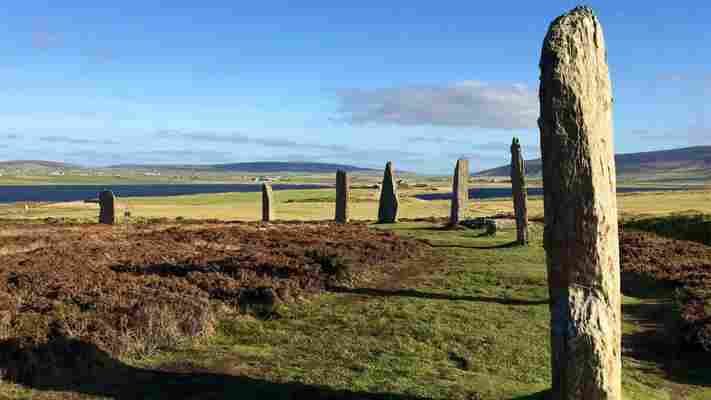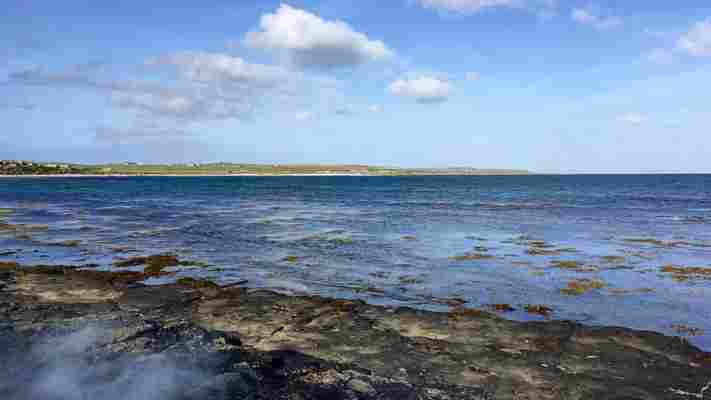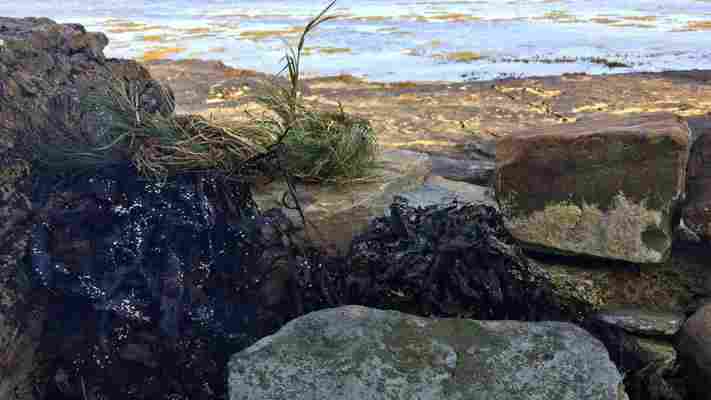Article continues below
The clouds passing over the island of Papa Westray graciously withheld their rain as I piled together dry wood, grass and seaweed. Setting a small pocket of dry thistle into the centre, I got to work with a handmade kit made up of two sticks, a reed bow and a bivalve shell – trying to convert muscle power into friction and friction into fire. If I could make enough heat to generate an ember, I’d have to transport it quickly into the thistle floss, where it could smoulder. I just had been trained in how to make fire as prehistoric people would have.
But so far, it wasn’t going well.
It is humbling to a 21st-Century denizen to realise he lacks the dexterity of a human born some 5,000 years ago. But a journey like mine quickly teaches that those we might call “primitive” today were in fact impressively skilled, inventive and cultured.
I was on a lonely wilderness mission through the Orkney Islands, an archipelago located off the northern coast of Scotland, to explore how people lived in a time before even the Egyptian pyramids or Stonehenge were built. But the first surprise is that – as shown in Orkney, where recent discoveries literally are rewriting our books on prehistory – these ancient Britons were far from “cavemen.”

Orkney’s Ring of Brodgar is just one sign that the Neolithic people who lived here were highly skilled and sophisticated (Credit: John Scott Lewinski)
“We’re discovering these people had a sophisticated society,” said Nick Card, senior project manager at the Orkney Research Centre for Archaeology . “They had religion. They appreciated art. They built and decorated their homes. And they formed communities with complex class structures.
“In an age before metals, these people managed to quarry stone, dig ditches, manage farms and erect stone circles like those around the Ness of Brodgar . Once you begin to understand the achievements of these people, nothing they did will surprise you.”
While prehistoric Britons learned these skills in order to survive, the pressure on me to master some of the same tasks was self-induced. My life was in no danger. The quiet, lush and green landscape of Papa Westray only covers about 3.5 miles, and as it has a population of around 75 people, I never was more than a manageable walk away from help if I made a genuine mess of it.
Those we might call 'primitive' today were in fact impressively skilled, inventive and cultured.
As I had learned that morning from Malcolm Handoll – Papa Westray resident, environmentalist and bushcraft instructor at Five Senses Eco-Tours – I also had time on my side. He had told me about the survival ‘Rules of Three’: if facing threatening conditions, a human being has three minutes to find breathable air, three hours to find warmth and shelter, three days to find water and three weeks to find food. My test was only for the day.
Still, I wanted to do this right and avoid shortcuts. That meant losing my shoes for the day and abandoning all technology. After a couple of hours of training that morning with Handoll, I was on my own. Fortunately, the spot I had chosen along the shoreline helped. The rock shelves facing the sea offered natural shelter and ideal angles to protect my fire from the wind. I was only a minute’s walk from streams and edible plants inland, while tidal pools in the other direction promised a foraging bonanza.

An ideal spot for wilderness training – as well as a beautiful one (Credit: John Scott Lewinski)
Now, Back on Papa Westray, I was surprised by my first accomplishment: the early stages of a successful fire. Generating hot ash from my seemingly endless grinding of wood against wood, I gently placed a tiny, surging glow into the thistle-down cocoon that would swaddle the ember until it matured enough for its move into the kindling. Gentle puffs of breath sent wisps of smoke back to my nostrils, signalling the immediate need to lower the minuscule conflagration into the kindling.
“They were masters of fire,” Handoll said. “They could create it, preserve it, transport it and share it. They had a constant source of warmth and a steady food supply thanks to farming, hunting, fishing and foraging. It was the mastery of their environment that allowed them the concept of organised, communal, surplus time – time to erect standing stones, time to create, time to be social.”
Handoll and Five Senses allow travellers to experience life under similar conditions as people would have in Neolithic Orkney: without electricity, modern technology or even shoes.
“Standing out in the wild, without shoes, their phones taken away from them – it scares the hell out of them at first,” Handoll told me of his clients. “But as they learn new skills and work together, they become more genuinely social again and begin to understand that learning how people lived in the past can help them make sense of how we’re living today.”

Making fire as our prehistoric ancestors did is a laborious process (Credit: John Scott Lewinski)
My experience of Neolithic life so far seemed less than sensible or social, but I had my fire slowly building. Now adequate for providing warmth, it was time to put the blaze to work cooking. While Neolithic humans farmed and hunted, I only had time for a bit of foraging. The tide was heading out along the edges of Papa Westray, revealing fresh pickings in the rich sea water pools. Limpets – essentially sea snails tucked into a shell about the size of a 50p coin – studded every rock. While their protein seemed like easy pickings, they adhered to the stones with a ferocity evolved through the ages.
To harvest a limpet, the gatherer must choose a flat, thick rock to knock the limpet free of its anchoring and into the waiting water. But the harvester gets only one chance. Misfire and leave the limpet in place, and the creature chemically welds itself to its perch. It will not be moved until the tide returns.
Limpets are abundant in Orkney… but surprisingly difficult to harvest (Credit: John Scott Lewinski)
According to Julie Gibson, head archaeologist for the Orkney Islands Council, communities developed here 5,000 years ago precisely so they would not have to worry about finding food.
“Neolithic Orkney had a unique position,” Gibson said. “The North Atlantic drift created a more mild climate. The soil was very fertile. And the isolated region protected the people from invasion.”
That protection gave the Neolithic population time to build sites like Skara Brae – a well-preserved village which was unearthed over the last 160 years. The Unesco World Heritage site revealed homes, workshops and other structures that yielded endless insights into how the village inhabitants lived.
“Geophysics suggest Skara Brae was probably two or three times the size of what we see today,” Gibson said. But, she added, “Significant finds of Orkney archaeology are eroding into the sea constantly due to natural processes – making our ongoing archaeological work all the more urgent.”
Skara Brae is a 5,000-year-old village whose houses and workshops you still can visit today (Credit: Alamy)
Leaving quite a few irritated, but stationary limpets waiting for the sea’s return, I eventually gained enough dexterity to harvest a handful. They waited in a pouch while I gathered fresh well water, a few root vegetables and whatever herbs I could identify. That recipe collection begged a simple question: Could I prepare a simple, hot Neolithic meal?
With the sun setting and the temperature dropping, I made sure my fire was healthy and secure. I stockpiled dry fuel so the flames would burn into the night. While I still had enough fading sun to see what I was doing, I placed a period-proper, fired earthenware pot Handoll had provided atop my fire and filled it with water and my foraged ingredients.
After an hour of boiling shelled limpets, vegetables and fresh herbs, I ended up with a bland mixture of rubbery snails and half-cooked turnips. Neither chefs of today or from 5,000 years ago would be impressed.
Learning how people lived in the past can help them make sense of how we’re living today.
I didn’t care. I was cold. I was hungry. So, I ate it – with burgeoning respect for the men and women who no doubt took everything I had to work with that day on Papa Westray and managed a better meal, and a better life, with all of it.
As night fell and a blanket of constellations rolled out in an Orkney sky unfettered by light pollution, I sat in my rocky shelter, exhausted, filthy and reeking of smoke and sea spray. Still, I was warm, fed and watered – all thanks to my own labour and Handoll’s instruction.
I felt a modest connection to some nameless Orkney man of 50 centuries ago who may have sat beside his own fire, staring up at largely the same stars.
This story is a part of BBC Britain – a series focused on exploring this extraordinary island, one story at a time. See every BBC Britain story by heading to the Britain homepage ; you can also follow us on Facebook and Twitter .
